14.09 / 13.10 2019
Artists/Listamenn:
Artists/Listamenn:
Sonia Levy, Karen Kramer
Curator/Sýningarstjóri: Gústav Geir Bollason
Text/Texti: Nella Aarne ( see below )
Translation/Þýðing: Margrét Elísabet Ólafsdóttir



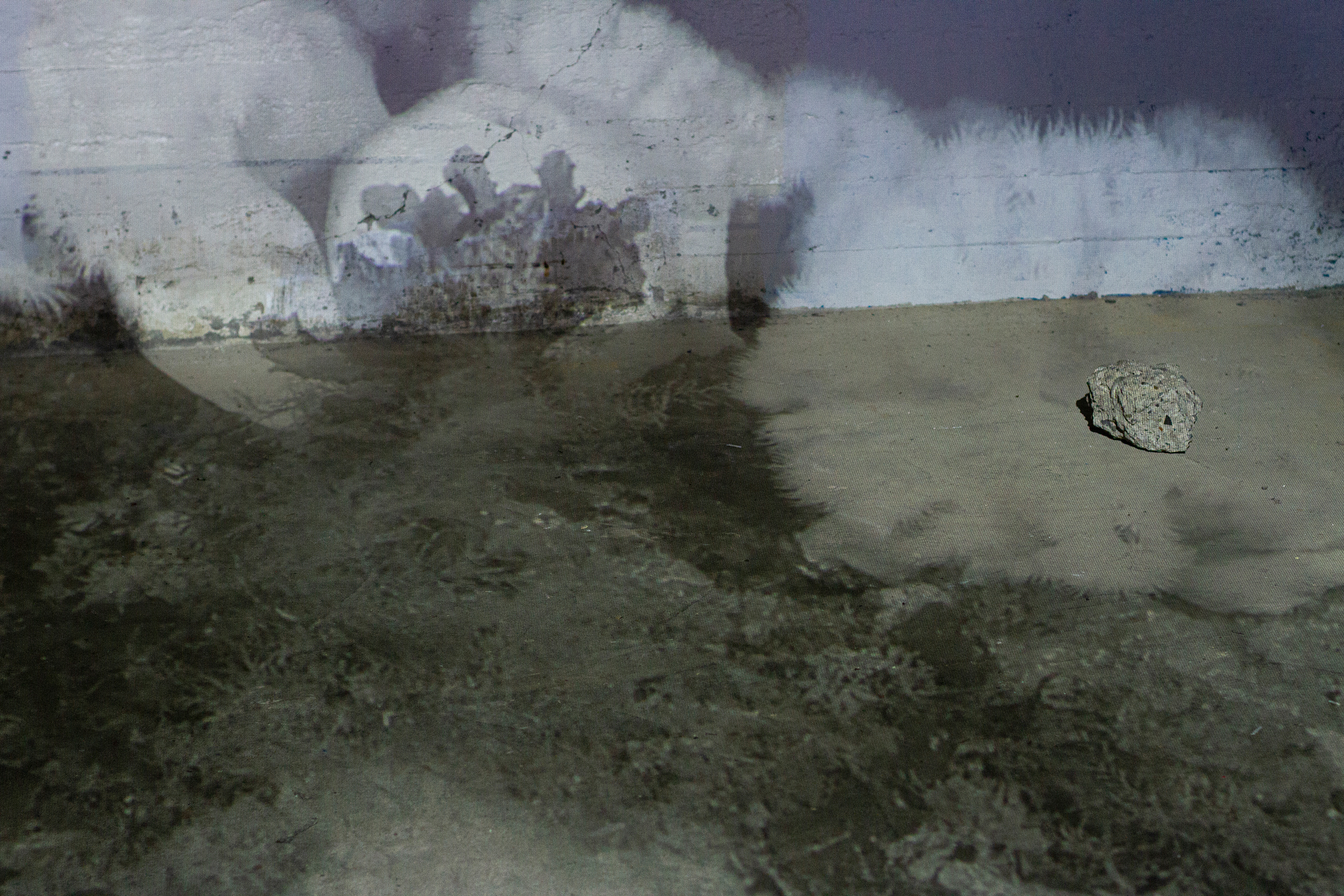
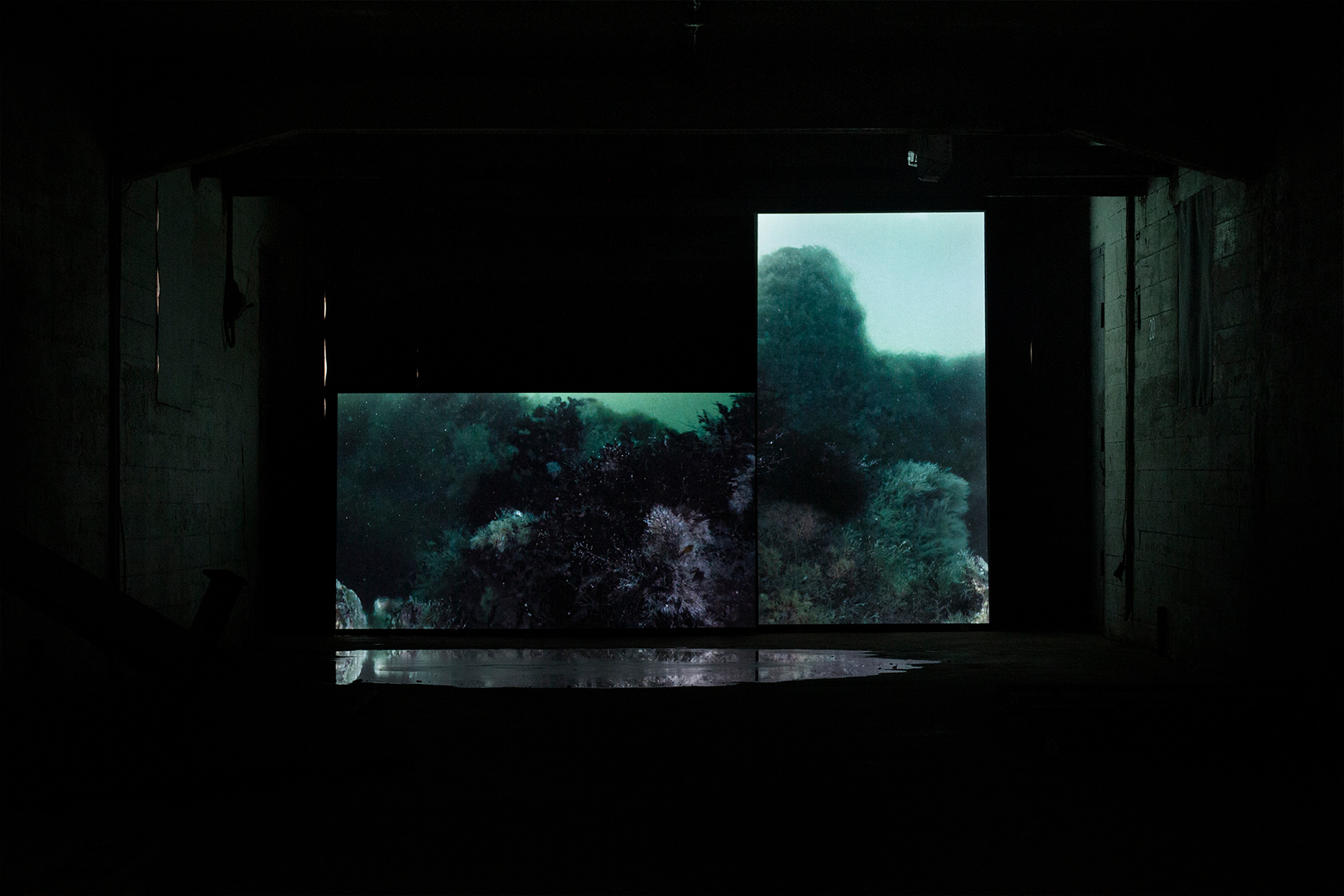
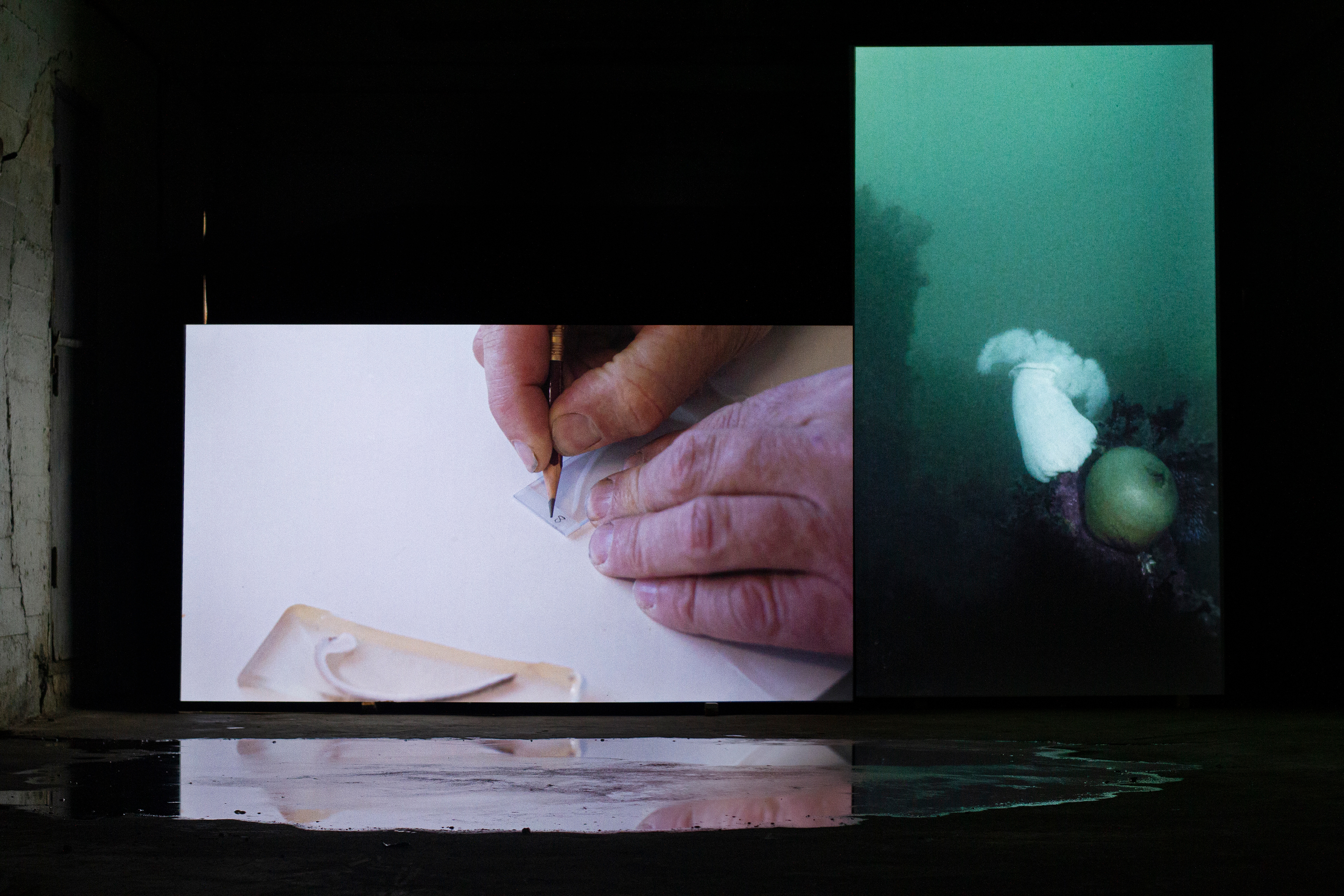
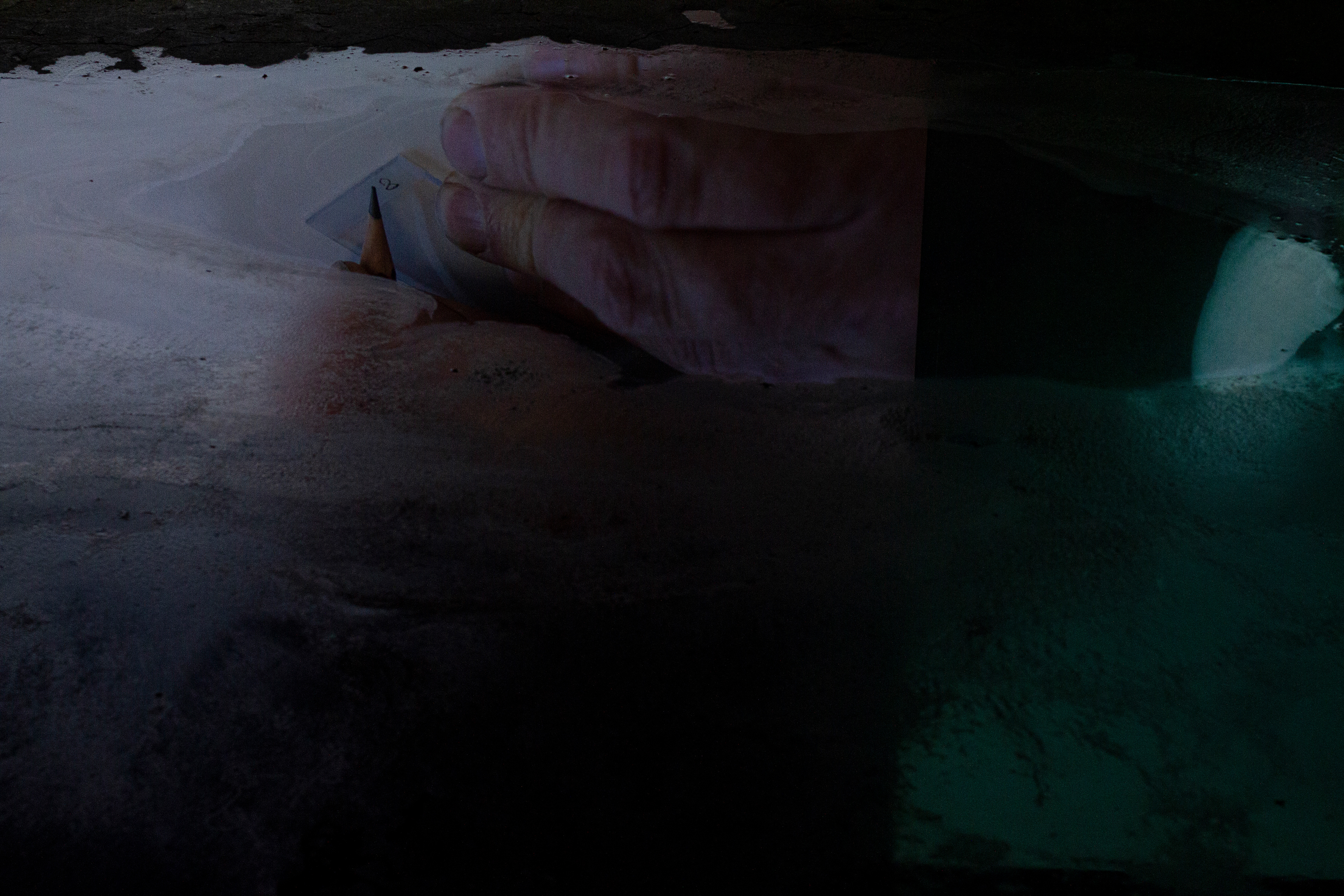
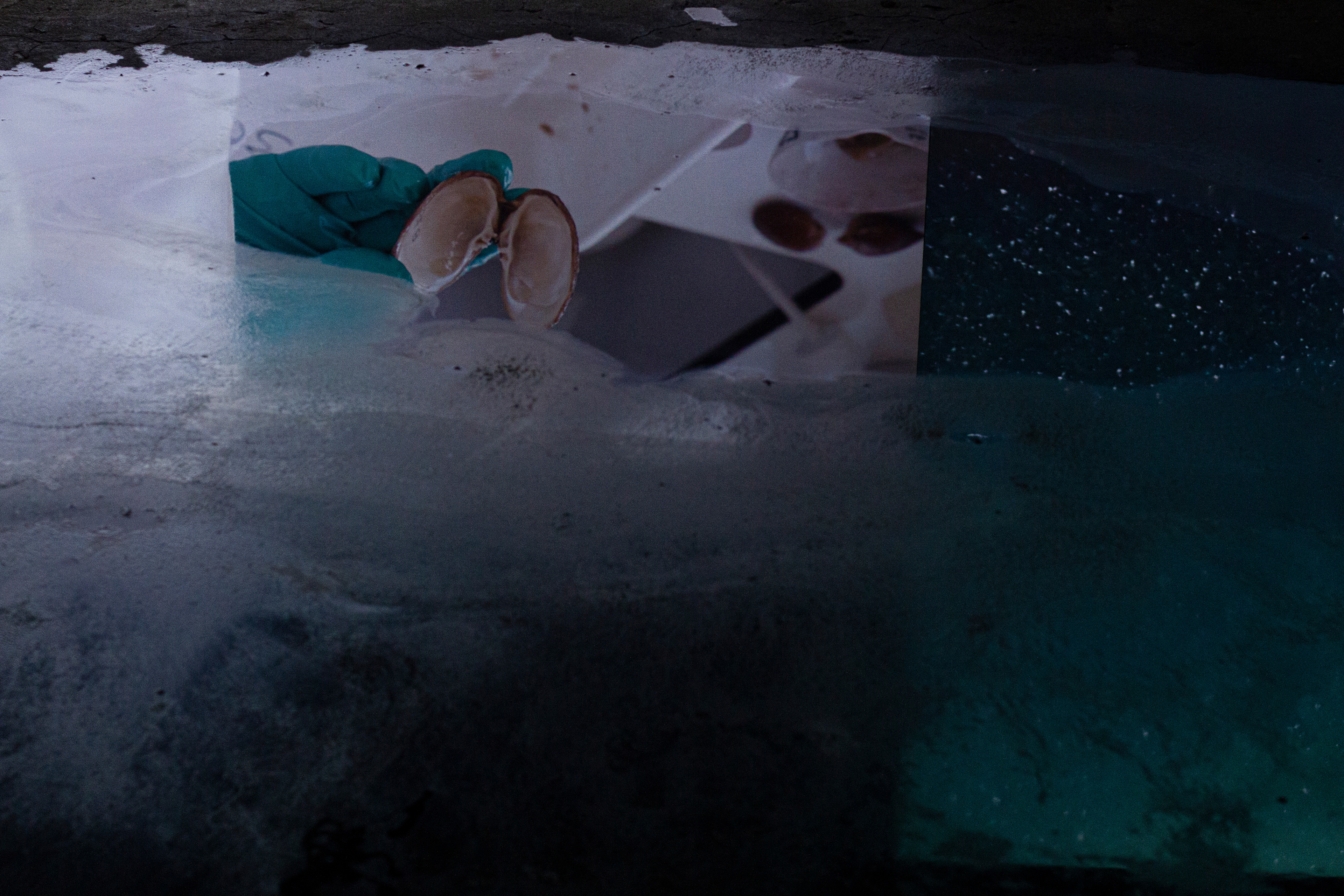

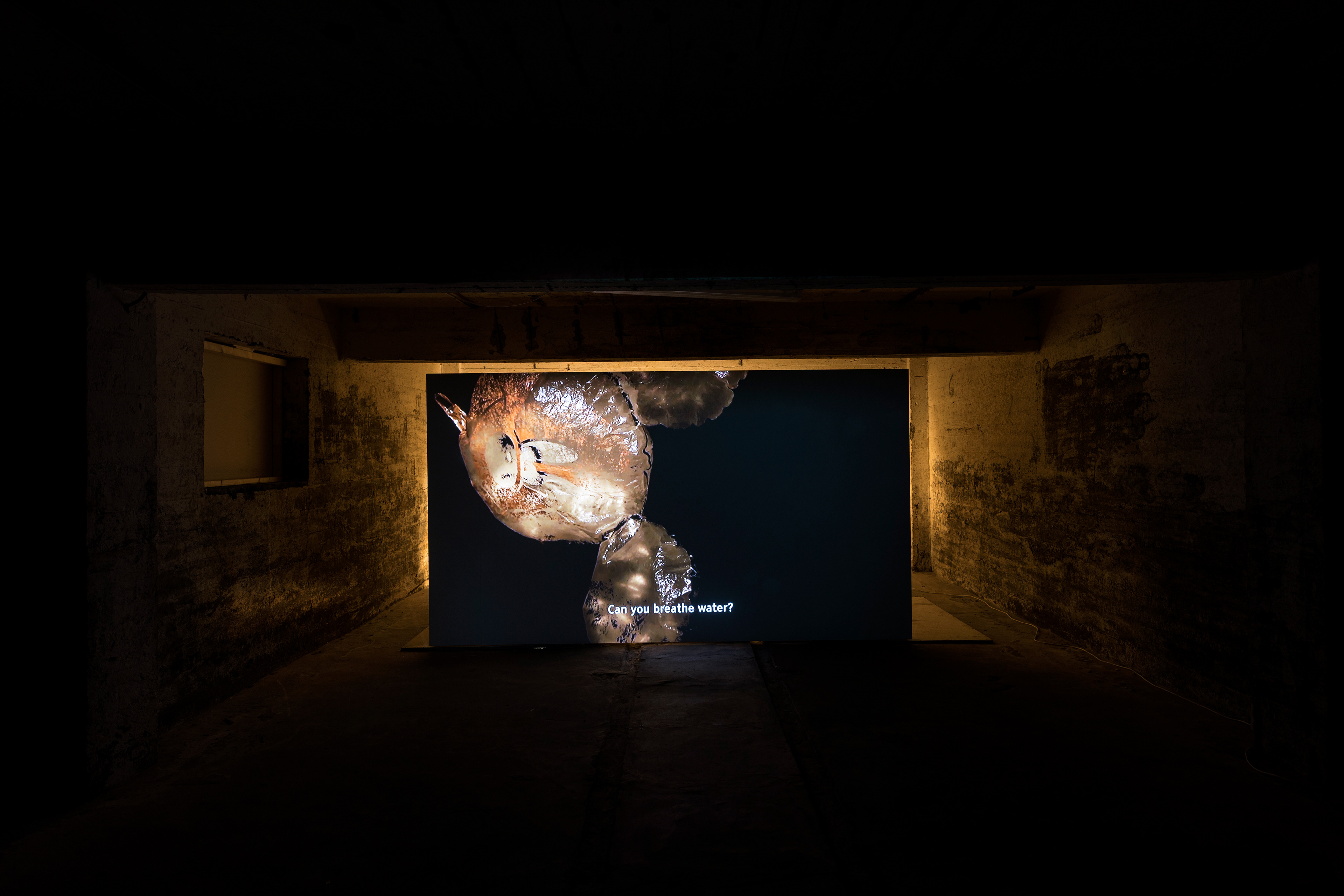
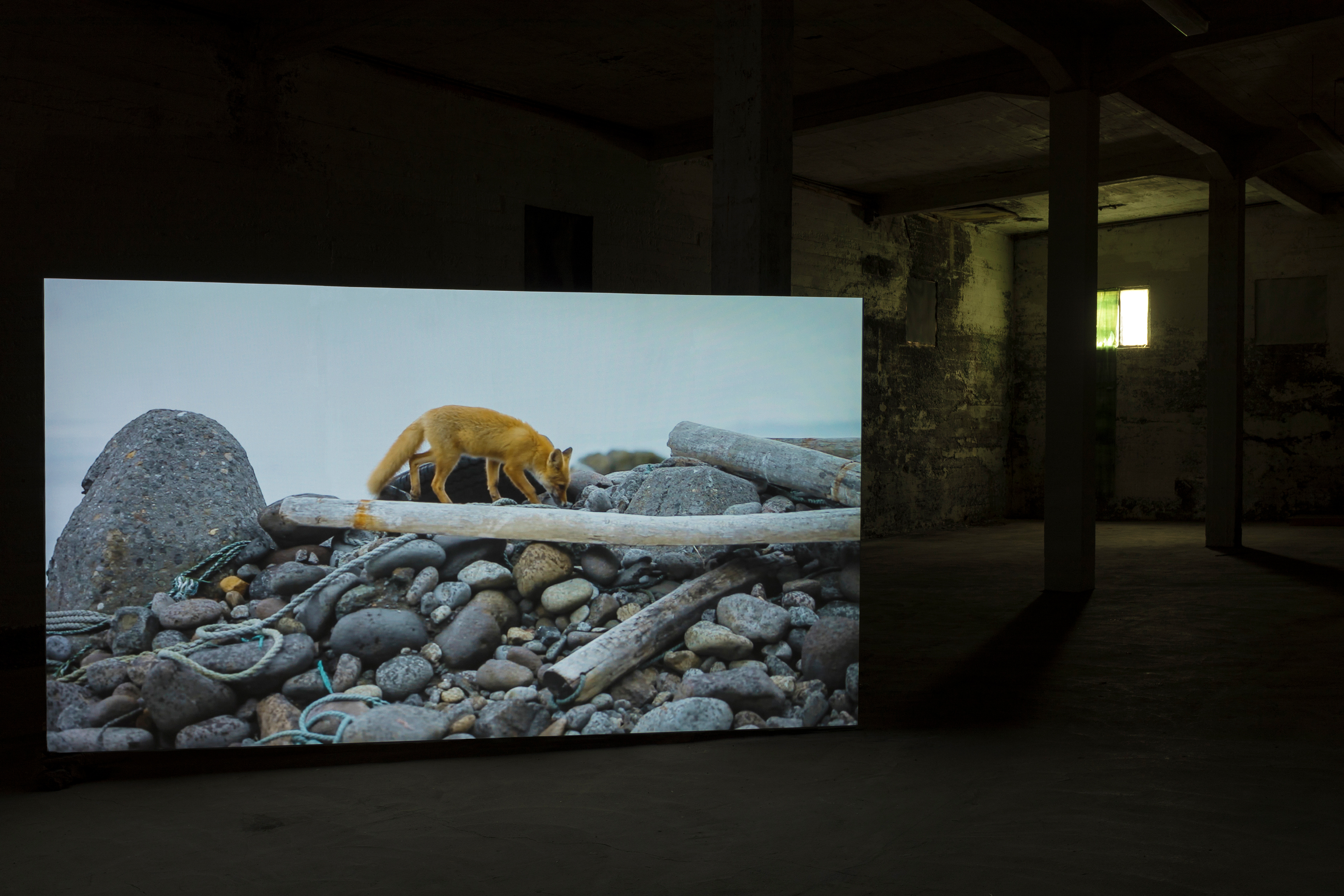



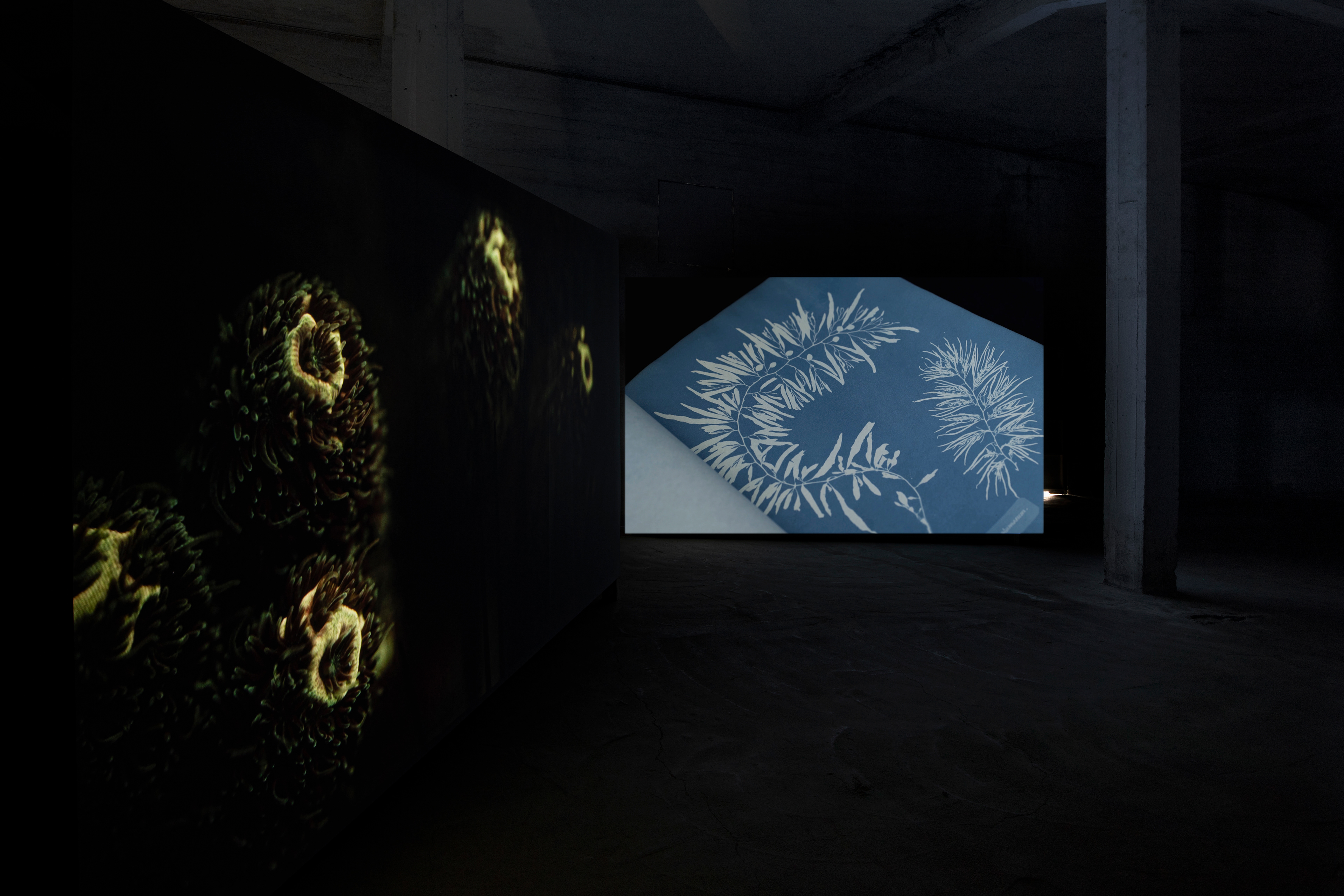
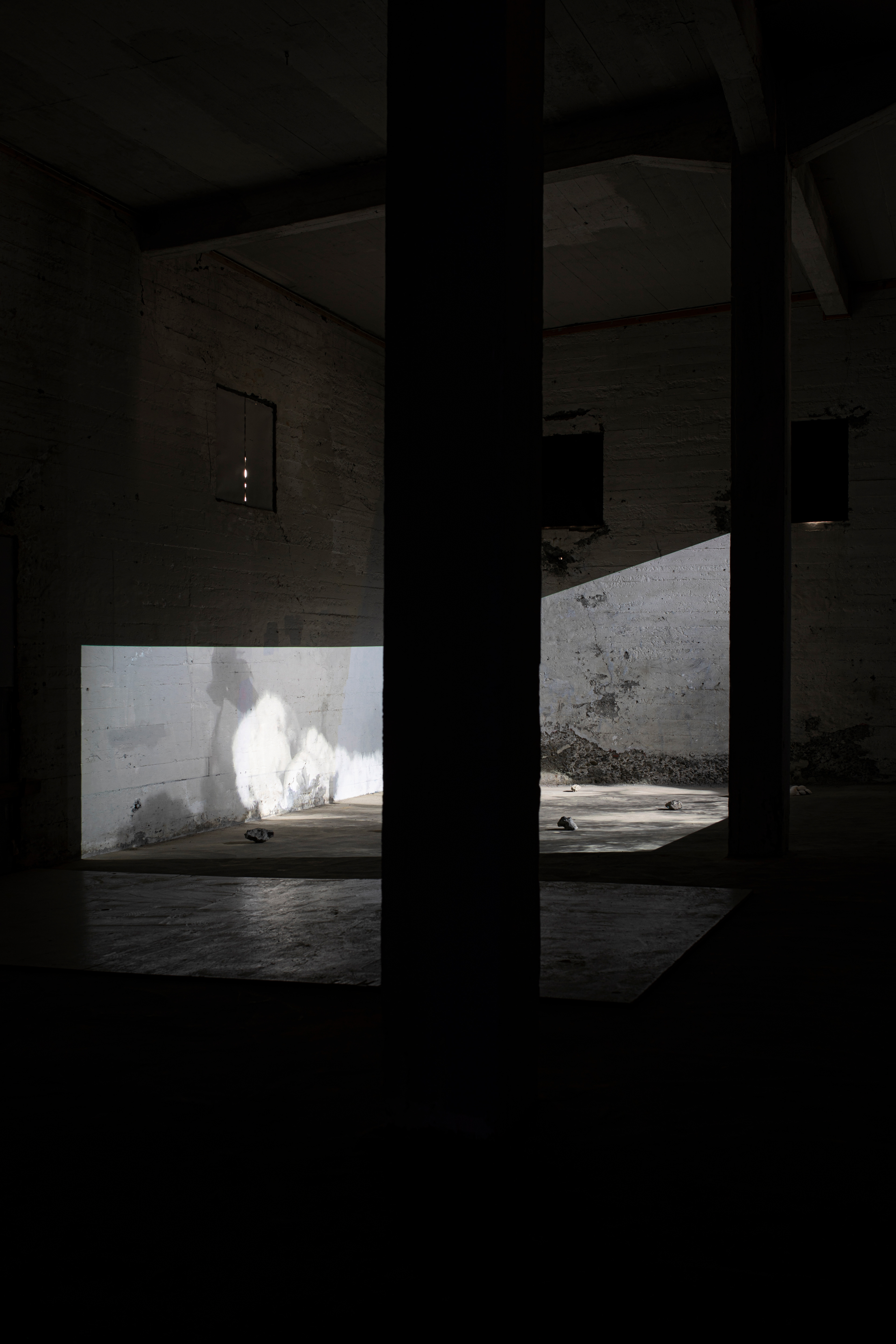
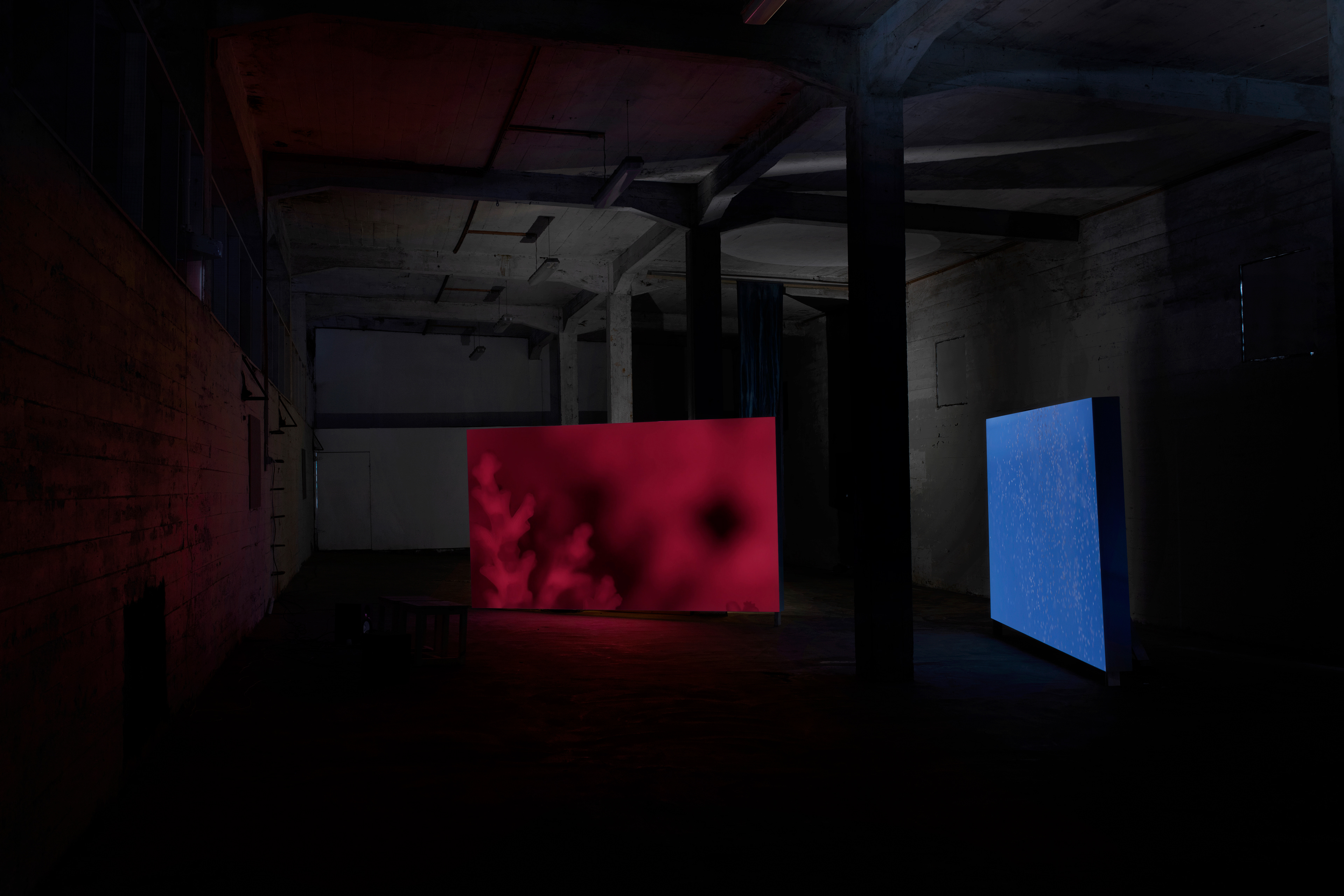
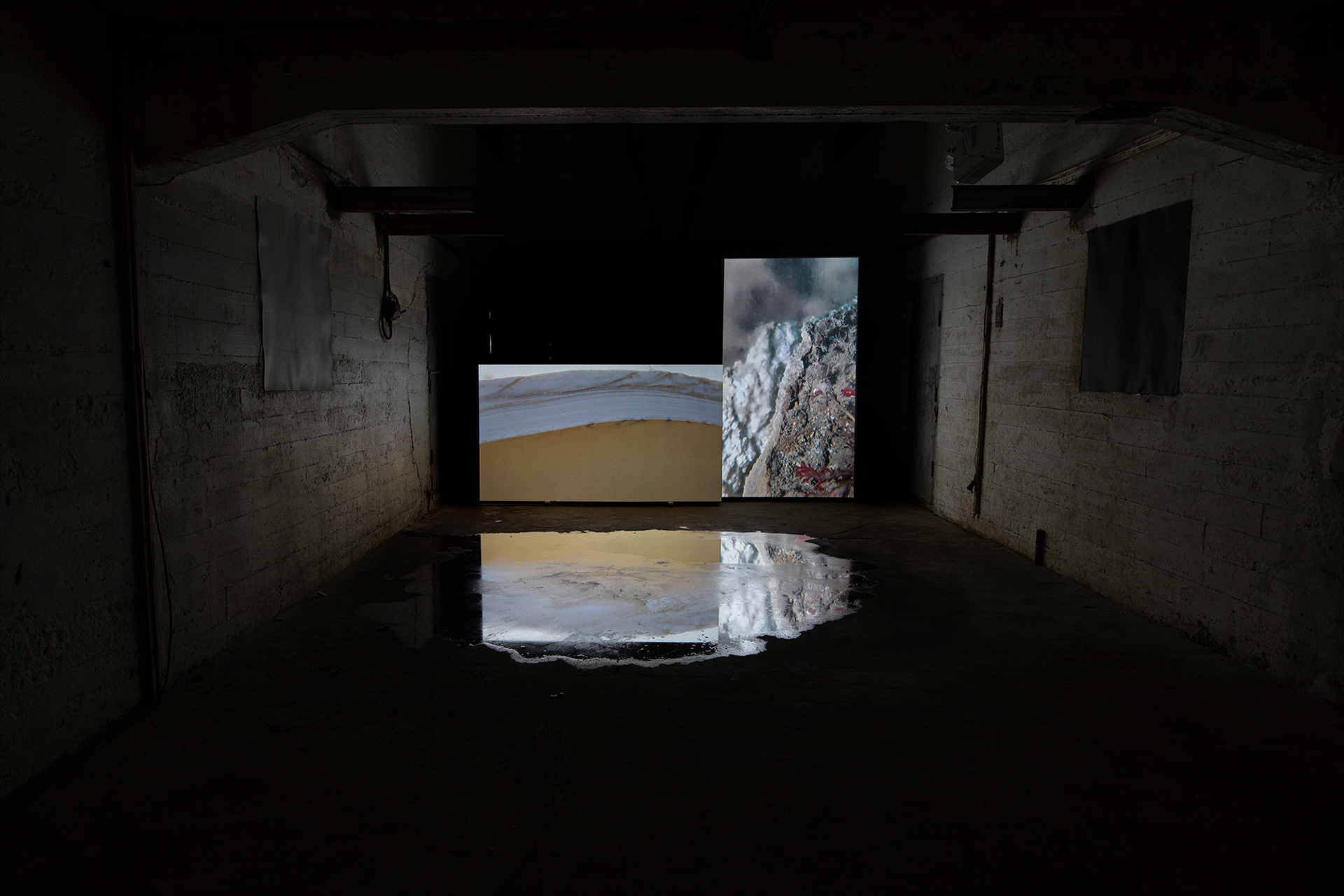
Artists Sonia Levy and Karen Kramer submerge Verksmiðjan á Hjalteyri into the depths of the sea with Hafrún. The first collaborative exhibition between the two London based artists, Hafrún interweaves Levy and Kramer’s sustained enquiry into marine life, anthropogenic environmental change and entanglements between lifeforms and ecosystems through installation and artist moving image. The exhibition is saturated with the history of its architectural context, a former herring factory, which was swiftly constructed with a concrete mix of cement, aggregate and seawater to respond to the needs of the fishing industry in 1950. Since then abandoned by the profit-making agents who commissioned it, the old factory is now a ruin of industrial production, vibrant with the traces of watery histories embedded to its materiality.
Hafrún is the name given posthumously to the oldest known ocean quahog, who was dredged off the coast of Grímsey in 2006 and died soon after in the hands of scientists. At the time of being captured, Hafrún was 507 years old, having lived through all three historical eras that have been proposed to mark the beginning of the Anthropocene: the Western colonial invasion of the Americas, the Industrial Revolution, and the 20th century Great Acceleration, characterised by the rapid development of nuclear technologies. Like the growth rings of trees, ocean quahogs’ shells carry a detailed record of the conditions in which the clams have lived. The shells are now studied as material archives that capture centuries of environmental change and, with paradigms developed by the Intergovernmental Panel on Climate Change, they are analysed to forecast ecological futures of the planet.
The exhibition is anchored in Levy’s eponymous project (Hafrún, 2019) filmed in collaboration with diver Erlendur Bogasson. The two-channel video installation portrays the laboratory process of collecting data from ocean quahogs’ shells. The shells are meticulously numbered, measured, embedded in resin and cut to study the patterns within their intricate internal layers, which on a microscopic scale evoke topographic maps of ancient landscapes. The rigorous process of extraction and analysis is paired with Bogasson’s underwater footage from a series of hydrothermal vents at an unusually shallow depth near the northern coast of Iceland. It is near these vents where Hafrún was found over a decade ago. These openings on the seafloor, through which geothermally heated water flows into the cold sea, host complex communities of marine organisms and have been theorised as one possible location for the origin of life.
Hafrún’s sex was never determined, but their given name is feminine and denotes a mysterious symbol connected to the sea. Evoking the notion of Woman as the mysterious other and the deep, dark sea as otherworldly and unfathomable in its vastness, the case of Hafrún brings forth the prevailing association between the sea and women’s bodies. Both appear in the Western cultural imaginary as unpredictable, controlled by liquid flows, attuned to the moon and, above all, as generators of life. But as feminist scholar Astrida Neimanis writes, watery embodiment is not only specific to women or femininity but, rather, is something to which we are all equally connected. The main constituent component of our bodies, water flows through all of us without differentiation, sustains us and, through our dependence on it, inherently connects us to other bodies of water.
Levy’s For the Love of Corals (2018), the predecessor of Hafrún, addresses our indebtedness to, and responsibility towards, our aqueous companions. The project follows a team of marine biologists and aquarists in the basement of the Horniman Museum and Gardens in London, as they work on their pioneering coral reproduction research. By simulating the environmental conditions of the Great Barrier Reef in their ad-hoc laboratory, the team became the first in the world to successfully breed corals in captivity. Levy’s two-channel film examines the potential of the museum to host a collaborative survival endeavour between species, as new paradigms for environmental conservation and natural history emerge in the face of accelerated ecological decline. While the museum context may still echo the Enlightenment values of human mastery over nature — after all, the corals are kept in captivity as part of the Horniman’s ‘living collection’ — the shared attempt to save corals from their anthropogenic extinction also establishes a new generative assemblage of living beings and biotechnology. Levy shows how the scientists and the coral create their own world in common through the daily labour of life-affirming care.
Although Levy, too, maintains an ambivalent attitude towards scientific innovation, it is in Kramer’s filmic fables that humans’ technological advances, especially in their collisions with bodies of water, unfold the full extent of their ominous potential. In Limulus (2013), a deflated Mickey Mouse balloon, now worn and forgotten ocean debris, relates its encounter with a horseshoe crab on the ocean floor. Our ghostly narrator has borne witness to the distress of the aquatic being who, after 450 million years on Earth, is now on the brink of extinction because humans have ceaselessly harvested its blood for pharmaceutical consumption. The tale is interjected by a Seeburg Olympian jukebox, a recent yet already redundant technological invention, accentuating the short-lived relevance of human endeavours. With Limulus, Kramer attends to timescales beyond human existence to make palpable the damage that our self-preserving species has caused to prehistoric life forms, next to whom our own appearance on this planet is only a brief sojourn.
Hafrún, For the Love of Corals and Limulus articulate the myriad ways in which humans have studied, intervened with, harvested from and sought to master bodies of water. Diverting from this narrative, Kramer’s The eye that articulates belongs on land (2016) portrays water as a fundamentally uncontrollable force that also holds power over life on terra firma. Scanning the coastal landscapes of eastern Japan affected by the Tōhoku earthquake and tsunami, which led to the Fukushima Daiichi nuclear disaster, the film considers the threshold between land and sea, and the unthinkable temporalities inherent to the aftermath of a nuclear meltdown. The roam across these deserted sites is guided by the narration of Sasaki, a mummified Hokkaido fox. An entity caught between worlds and temporalities, Sasaki recalls the catastrophic event and, grief-stricken, reflects on the insignificance of the coastline as the ostensible boundary, which humans had imagined would keep them separate from the sea. Kramer’s contemporary fable is a sombre gaze at the ramifications of hazardous human-made technologies reconfigured by natural forces.
At Verksmiðjan á Hjalteyri, Levy and Kramer float through and amongst bodies of water with care and caution, mindful of their vulnerability as well as their strength. With Kramer’s installation evoking the undulation of submerged reeds and Levy and Bogasson’s underwater footage, the artists bring to life the watery origins of the building itself. The concrete architecture of the capitalist ruin turns into a reef, where different life forms and ideas can again take hold to imagine futures beyond human existence. Brought together, Levy and Kramer’s work presents a generative expansion of artistic devices, through which it might be possible to address and grasp the intensity of the imminent ecological crises that have already begun to unfold.
Listamennirnir Sonia Levy og Karen Kramer færa Verksmiðjuna á Hjalteyri á kaf í undirdjúp sjávarins með sýningunni Hafrúnu. Þetta er fyrsta samstarfsverkefni Levy og Kramer, sem báðar eru búsettar í London en á sýningunni fléttast áhugi þeirra á sjárvarlífi, umhverfisáhrifum af mannavöldum og samofnum lífsformum og vistkerfum saman í gegnum innsetningar og kvikmyndir. Sýningin er gegnsýrð af byggingarsögulegu samhengi síldarverksmiðjunnar, sem var reist á skömum tíma úr steinsteypu til að svara þörfum sjávarútvegsins á sjötta áratug 20. aldar. Síðan var verksmiðjan yfirgefin af gróðafyrirtækinu sem stóð fyrir framkvæmdunum og nú er þessi gamla verksmiðja rústir iðnaðarframleiðslu, ómandi af ummerkjum um votar sögur sem eru greyptar í efni hennar.
Elstu kúskel sem veiðst hefur var gefið nafnið Hafrún eftir að hún var dregin á land í Grímsey árið 2006, þar sem hún lést í höndum vísindamanna. Þegar Hafrún var veidd var hún 507 ára gömul og hafði því lifað þau þrjú tímaskeið sögunnar sem talin eru marka upphaf mannaldar: innrásina í nýlenduríki Ameríku, iðnbyltinguna og Hröðunina miklu á 20 öld, sem einkennist af hraðri þróun kjarnorkutækni. Líkt og árhringir trés varðveitir skel kúfiskins nákvæmar upplýsingar um þær aðstæður sem skelin hefur lifað við. Skeljarnar eru rannsakaðar eins og efnislegt skjalasafn sem veitir upplýsingar um umhverfisáhrif margar aldir aftur í tímanum. Með viðmiðum sem hafa verið sett af Vísindanefnd Sameinuðu þjóðanna eru þessar upplýsingar greindar í þeim tilgangi að spá fyrir um framtíð vistkerfis jarðarinnar.
Akkeri sýningarinnar er samnefnd kvikmynd Soniu Levy, (Hafrún, 2019), sem hún tók upp með aðstoð Erlends Bogasonar kafara. Tveggja rása vídeóinnsetning sýnir ferlið sem á sér stað þegar gögnum frá kúskeljum í hafinu er safnað fyrir rannsóknarstofu. Skeljarnar eru vandlega merktar, mældar, greiptar í trjákvoðu og skornar til að rannska mynstrið innan í flóknu innra lagi þeirra, sem séð í smásjá minnir á landslagskort af fornu landslagi. Hárnkvæmt ferlið við nám og greiningu er sýnt við hlið myndskeiða Erlends Bogasonar af neðansjávarhitahverum á grynningum nálægt norðurströnd Íslands. Það er í grennd við þessa hveri sem Hafrún fannst fyrir rúmum áratug. Þessi göt á sjávarbotninum, þar sem hveravatnið flæðir upp í kaldan sjóinn, eru heimkynni sjávarlífvera og einn af mögulegum stöðum þar sem lífið gæti hafa átt uppruna sinn.
[...]
Eldri en Hafrún er kvikmyndin Af ást á kórölum (For the Love of Corals, 2018) en hún fjallar um skuld okkar og ábyrgð gagnvart förunautum okkar í hafinu. Við gerð myndarinnar var fylgst með teymi sjávarlíffræðinga og umsjónarmanna fiskibúra í kjallaranum á Horniman Museum and Gardens í London, þar sem þeir vinna frumkvöðlarannsóknir á tímgun kóralla. Með því að líkja eftir aðstæðum við Kóralrifið mikla á sérútbúinni rannsóknarstofu, varð teymið það fyrsta í heiminum til að tímga fangaða kóralla. Tveggja rása kvikmynd Soniu Levy skoðar hvort safnið geti haldið utan um samvinnuverkefni þess sameiginlega markmiðs tegundanna að lifa af, þar sem ný viðmið í umhverfisvernd og náttúrufræði koma fram og standa saman gagnvart hraðri hnignun vistkerfisins. Á sama tíma og safnið endurómar gildi Upplýsingarinnar þar sem maðurinn beislar náttúruna - þar sem kórölunum er í raun haldið föngum sem hluti af „lifandi safneign“ Hornimans safnsins – þá er sameiginlegur vilji til að bjarga kórölunum frá eyðileggingu mannsins skapandi tilraun til að sameina lifandi verur og líftækni. Levy sýnir hvernig vísindamennirnir og kóralarnir skapa sinn eigin sameiginlega heim í gegnum daglega vinnu og umhyggju fyrir lífinu.
Þótt afstaða Levys til vísindalegra framfara sé tvíræð er það í dæmisögu Karenar Kramer sem tækniframfarir mannsins, sérstaklega í átökum við líkama vatnsins, afhjúpa óheillavænlega getu sína til fulls. Í kvikmyndinni Sverðhalar (Limulus 2013) segir loftlaus Mikka mús blaðra, sem nú er orðin snjáð og gleymt rusli í hafinu, frá kynninum sínum af skeifukrabba á sjávarbotni. Draugalegur sögumaður okkar hefur orðið vitni að hörmungum vatnaverunnar, sem eftir að hafa lifað á jörðinni í 450 milljónir ára, er nú við það að deyja út vegna þess að maðurinn hefur ástundað gegndarlausa söfnun á blóði hennar til notkunar í lyfjafræði. Frásögnin er trufluð með innskotum frá Seeburg Olympian júkboxi, nýlegri en þó úreltri mannlegri uppfinningu, sem undirstrikar hlutfallslega stuttan líftíma viðleitni mannsins. Kramer beini athyglinni að tímakvarða sem er handan mannlegrar tilvistar til að gera áþreifanlega eyðilegginguna sem sjálfsbjargarhvöt okkar tegundar hefur valdið forsögulegum lífsformum, í hvers samanburði viðdvöld okkar á jörðinni er skömm.
[...]
Í Verksmiðjunni á Hjalteyri fljóta Levy og Kramer í gegnum og á meðal líkama vatnsins af umhyggju og varúð, þar sem þær eru sér meðvitaðar um viðkvæmni þeirra og styrkleika. Með innsetningu Kramers, sem minnir á bylgjuhreyfingar neðansjávarrifs og myndskeiðum Levy‘s og Erlends Bogasonar sem tekin eru neðansjávar, minna listamennirnir á uppruna byggingarinnar í vatninu. Steinsteypubygging hinna kapítalísku rústa breytist í rif þar sem ólík lífsform og hugmyndir geta gripið sig fasta og ímyndað sér framtíð handan við mannlega tilvist. Þegar verk Levys og Kramers koma saman sýna þau skapandi útvíkkun listræns hugvits sem mögulega væri hægt að virkja til að fjalla um og ná utan um ákafa hættunnar sem vofir yfir vistkerfinu og hefur smám saman verið að koma í ljós.
Elstu kúskel sem veiðst hefur var gefið nafnið Hafrún eftir að hún var dregin á land í Grímsey árið 2006, þar sem hún lést í höndum vísindamanna. Þegar Hafrún var veidd var hún 507 ára gömul og hafði því lifað þau þrjú tímaskeið sögunnar sem talin eru marka upphaf mannaldar: innrásina í nýlenduríki Ameríku, iðnbyltinguna og Hröðunina miklu á 20 öld, sem einkennist af hraðri þróun kjarnorkutækni. Líkt og árhringir trés varðveitir skel kúfiskins nákvæmar upplýsingar um þær aðstæður sem skelin hefur lifað við. Skeljarnar eru rannsakaðar eins og efnislegt skjalasafn sem veitir upplýsingar um umhverfisáhrif margar aldir aftur í tímanum. Með viðmiðum sem hafa verið sett af Vísindanefnd Sameinuðu þjóðanna eru þessar upplýsingar greindar í þeim tilgangi að spá fyrir um framtíð vistkerfis jarðarinnar.
Akkeri sýningarinnar er samnefnd kvikmynd Soniu Levy, (Hafrún, 2019), sem hún tók upp með aðstoð Erlends Bogasonar kafara. Tveggja rása vídeóinnsetning sýnir ferlið sem á sér stað þegar gögnum frá kúskeljum í hafinu er safnað fyrir rannsóknarstofu. Skeljarnar eru vandlega merktar, mældar, greiptar í trjákvoðu og skornar til að rannska mynstrið innan í flóknu innra lagi þeirra, sem séð í smásjá minnir á landslagskort af fornu landslagi. Hárnkvæmt ferlið við nám og greiningu er sýnt við hlið myndskeiða Erlends Bogasonar af neðansjávarhitahverum á grynningum nálægt norðurströnd Íslands. Það er í grennd við þessa hveri sem Hafrún fannst fyrir rúmum áratug. Þessi göt á sjávarbotninum, þar sem hveravatnið flæðir upp í kaldan sjóinn, eru heimkynni sjávarlífvera og einn af mögulegum stöðum þar sem lífið gæti hafa átt uppruna sinn.
[...]
Eldri en Hafrún er kvikmyndin Af ást á kórölum (For the Love of Corals, 2018) en hún fjallar um skuld okkar og ábyrgð gagnvart förunautum okkar í hafinu. Við gerð myndarinnar var fylgst með teymi sjávarlíffræðinga og umsjónarmanna fiskibúra í kjallaranum á Horniman Museum and Gardens í London, þar sem þeir vinna frumkvöðlarannsóknir á tímgun kóralla. Með því að líkja eftir aðstæðum við Kóralrifið mikla á sérútbúinni rannsóknarstofu, varð teymið það fyrsta í heiminum til að tímga fangaða kóralla. Tveggja rása kvikmynd Soniu Levy skoðar hvort safnið geti haldið utan um samvinnuverkefni þess sameiginlega markmiðs tegundanna að lifa af, þar sem ný viðmið í umhverfisvernd og náttúrufræði koma fram og standa saman gagnvart hraðri hnignun vistkerfisins. Á sama tíma og safnið endurómar gildi Upplýsingarinnar þar sem maðurinn beislar náttúruna - þar sem kórölunum er í raun haldið föngum sem hluti af „lifandi safneign“ Hornimans safnsins – þá er sameiginlegur vilji til að bjarga kórölunum frá eyðileggingu mannsins skapandi tilraun til að sameina lifandi verur og líftækni. Levy sýnir hvernig vísindamennirnir og kóralarnir skapa sinn eigin sameiginlega heim í gegnum daglega vinnu og umhyggju fyrir lífinu.
Þótt afstaða Levys til vísindalegra framfara sé tvíræð er það í dæmisögu Karenar Kramer sem tækniframfarir mannsins, sérstaklega í átökum við líkama vatnsins, afhjúpa óheillavænlega getu sína til fulls. Í kvikmyndinni Sverðhalar (Limulus 2013) segir loftlaus Mikka mús blaðra, sem nú er orðin snjáð og gleymt rusli í hafinu, frá kynninum sínum af skeifukrabba á sjávarbotni. Draugalegur sögumaður okkar hefur orðið vitni að hörmungum vatnaverunnar, sem eftir að hafa lifað á jörðinni í 450 milljónir ára, er nú við það að deyja út vegna þess að maðurinn hefur ástundað gegndarlausa söfnun á blóði hennar til notkunar í lyfjafræði. Frásögnin er trufluð með innskotum frá Seeburg Olympian júkboxi, nýlegri en þó úreltri mannlegri uppfinningu, sem undirstrikar hlutfallslega stuttan líftíma viðleitni mannsins. Kramer beini athyglinni að tímakvarða sem er handan mannlegrar tilvistar til að gera áþreifanlega eyðilegginguna sem sjálfsbjargarhvöt okkar tegundar hefur valdið forsögulegum lífsformum, í hvers samanburði viðdvöld okkar á jörðinni er skömm.
[...]
Í Verksmiðjunni á Hjalteyri fljóta Levy og Kramer í gegnum og á meðal líkama vatnsins af umhyggju og varúð, þar sem þær eru sér meðvitaðar um viðkvæmni þeirra og styrkleika. Með innsetningu Kramers, sem minnir á bylgjuhreyfingar neðansjávarrifs og myndskeiðum Levy‘s og Erlends Bogasonar sem tekin eru neðansjávar, minna listamennirnir á uppruna byggingarinnar í vatninu. Steinsteypubygging hinna kapítalísku rústa breytist í rif þar sem ólík lífsform og hugmyndir geta gripið sig fasta og ímyndað sér framtíð handan við mannlega tilvist. Þegar verk Levys og Kramers koma saman sýna þau skapandi útvíkkun listræns hugvits sem mögulega væri hægt að virkja til að fjalla um og ná utan um ákafa hættunnar sem vofir yfir vistkerfinu og hefur smám saman verið að koma í ljós.